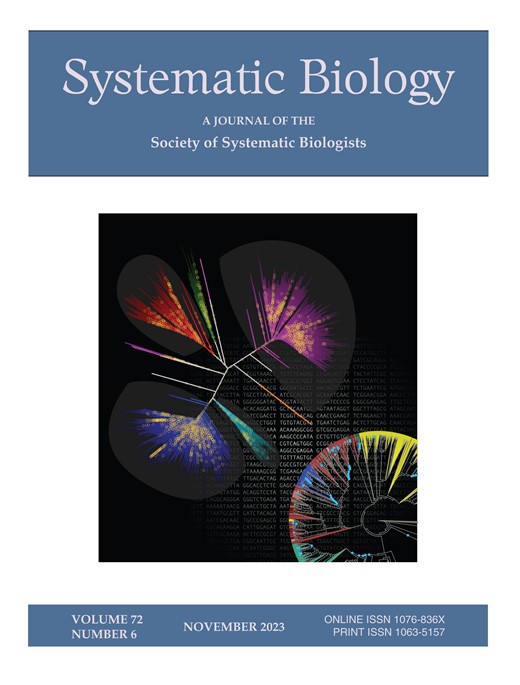从转录组数据中推断出Acoelomorpha的系统进化骨架
IF 5.7
1区 生物学
Q1 EVOLUTIONARY BIOLOGY
引用次数: 0
摘要
Xenacoelomorpha大多是微小的、形态简单的蠕虫,缺乏其他双脊类动物的许多典型结构。Xenacoelomorphs包括三大类:Acoela、Nemertodermatida和Xenoturbella:Acoela、Nemertodermatida和Xenoturbella--曾被认为是早期分化的双鞭毛目动物,是原肠动物和去壳动物的姊妹,但其他系统发生学分析发现,这一支系嵌套在去壳动物中,是Ambulacraria的姊妹。可以理解的是,Xenacoelomorpha 在后生动物树中的位置引起了广泛的关注,这给该类群内部的系统发育关系研究蒙上了阴影。鉴于Xenoturbella仅包括6个物种,而这些物种之间的关系已十分清楚,我们决定重点研究物种最多的Acoelomorpha(Acoela + Nemertodermatida)。在这里,我们对 29 个转录组进行了测序,使测序物种的数量增加了一倍,从而根据基因组数据推断出 Acoelomorpha 的骨干树。所恢复的拓扑结构与之前的研究基本一致。最重要的不同之处在于,我们发现 Paratomella 是 Acoela 的第一个分支,这极大地改变了祖先 acoel 的重建。此外,我们还发现了基因树与物种树之间的不一致性,这很可能与不完全的世系分类有关,而且 Dakuidae 科与 Mecynostomidae 科之间也存在一些外来入侵信号,这妨碍了推断该科,尤其是 Notocelis 属的正确位置。我们还利用该数据集首次推断了Acoelomorpha科的分化时间,该时间与已知的两栖动物分化和灭绝事件相吻合。鉴于形态学数据在无尾目系统发生学中的重要性,我们测试了多个分区和模型。尽管形态学数据未能恢复一个稳健的系统发生,但事实证明,在有参考系统发生的情况下,系统发生定位是一个合适的替代方法。本文章由计算机程序翻译,如有差异,请以英文原文为准。
A Phylogenomic Backbone for Acoelomorpha Inferred from Transcriptomic Data
Xenacoelomorpha are mostly microscopic, morphologically simple worms, lacking many structures typical of other bilaterians. Xenacoelomorphs –which include three main groups: Acoela, Nemertodermatida, and Xenoturbella– have been proposed to be an early diverging Bilateria, sister to protostomes and deuterostomes, but other phylogenomic analyses have recovered this clade nested within the deuterostomes, as sister to Ambulacraria. The position of Xenacoelomorpha within the metazoan tree has understandably attracted a lot of attention, overshadowing the study of phylogenetic relationships within this group. Given that Xenoturbella includes only six species whose relationships are well understood, we decided to focus on the most speciose Acoelomorpha (Acoela + Nemertodermatida). Here, we have sequenced 29 transcriptomes, doubling the number of sequenced species, to infer a backbone tree for Acoelomorpha based on genomic data. The recovered topology is mostly congruent with previous studies. The most important difference is the recovery of Paratomella as the first off-shoot within Acoela, dramatically changing the reconstruction of the ancestral acoel. Besides, we have detected incongruence between the gene trees and the species tree, likely linked to incomplete lineage sorting, and some signal of introgression between the families Dakuidae and Mecynostomidae, which hampers inferring the correct placement of this family and, particularly, of the genus Notocelis. We have also used this dataset to infer for the first time diversification times within Acoelomorpha, which coincide with known bilaterian diversification and extinction events. Given the importance of morphological data in acoelomorph phylogenetics, we tested several partitions and models. Although morphological data failed to recover a robust phylogeny, phylogenetic placement has proven to be a suitable alternative when a reference phylogeny is available.
求助全文
通过发布文献求助,成功后即可免费获取论文全文。
去求助
来源期刊

Systematic Biology
生物-进化生物学
CiteScore
13.00
自引率
7.70%
发文量
70
审稿时长
6-12 weeks
期刊介绍:
Systematic Biology is the bimonthly journal of the Society of Systematic Biologists. Papers for the journal are original contributions to the theory, principles, and methods of systematics as well as phylogeny, evolution, morphology, biogeography, paleontology, genetics, and the classification of all living things. A Points of View section offers a forum for discussion, while book reviews and announcements of general interest are also featured.
 求助内容:
求助内容: 应助结果提醒方式:
应助结果提醒方式:


